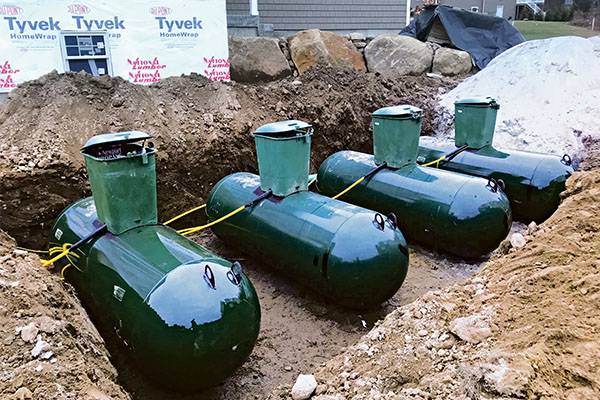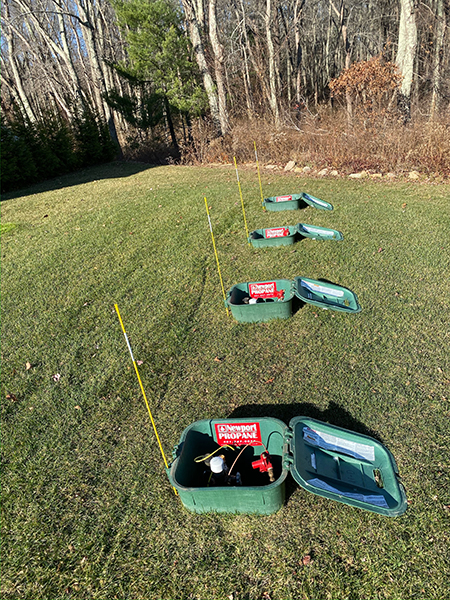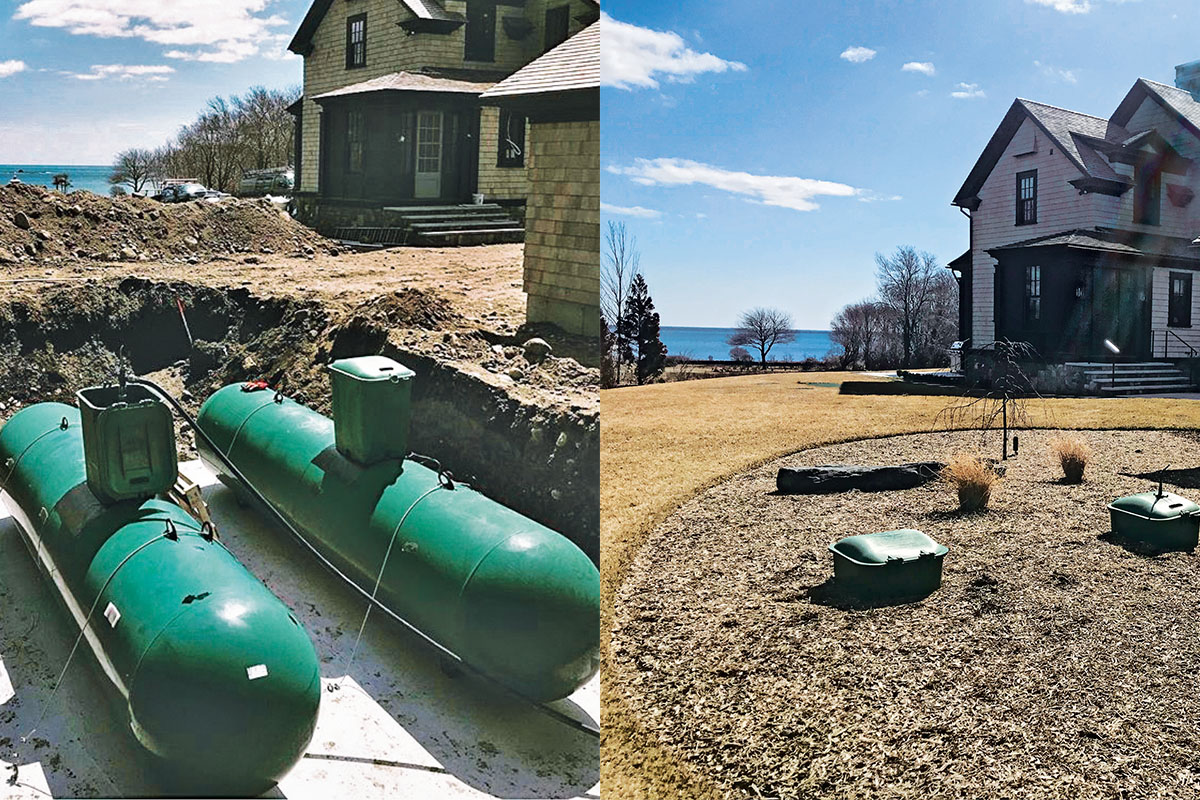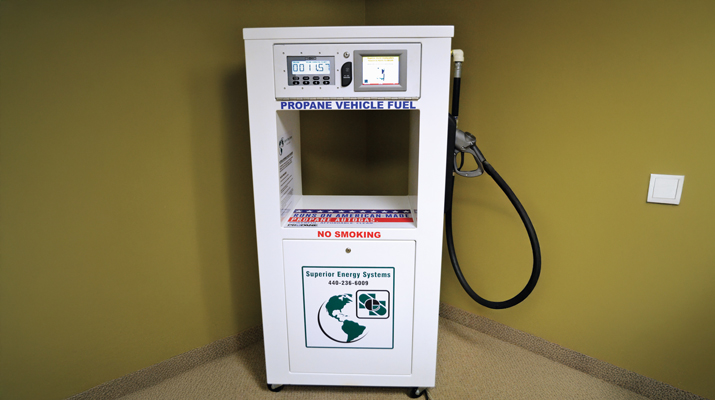Two propane marketers boost business with underground tanks
In the long list of tasks propane marketers can do “with their eyes closed,” placing tanks probably ranks near the top.
But most agree an underground tank installation adds an extra layer of time, money and effort.

Demand for underground tanks often follows new construction activity. (Photo by Peter Sherman, Donnie Pelletier)
Nevertheless, Mississippi-based Blossman Gas has made burying tanks a matter of routine. The company has experienced a dramatic shift toward underground tanks over the past several decades.
Twenty-five years ago, less than 5 percent of Blossman’s company tanks were buried underground, says Stuart Weidie, president and CEO. Today, it’s about a third. Underground tanks also account for 60 percent of the company’s total tank installations and an even higher percentage of residential tank installations.
Blossman’s business development strategy has contributed to that shift.
Like many in the propane industry, says Weidie, Blossman has made a concerted effort to target high-end or custom homes with higher propane loads – for space heating as well as water heating, cooking and other applications.
In these affluent neighborhoods, homeowners associations may require that propane tanks be buried, and many customers prefer a tank that’s not visible in the yard, explains Weidie.
For Blossman, an underground tank is a solution that not only works well for the customer but also competes effectively against other energy sources and elevates public perception of propane.
“Any home or business that’s not on natural gas, we consider a potential propane customer, and our industry should view it that way,” says Weidie. “So if it requires us to bury or put an underground tank in to please the customer, as opposed to something being all electric or another energy source, we’re going to put the underground tank in because we want that customer.”
An underground propane tank can also provide an experience comparable to natural gas service, explains Weidie, especially when customers are on a keep-full schedule and regular payment plan that automates customer service.
“It adds to the perceived convenience of propane as an energy source in homes and businesses,” he says.
Weidie notes that a robust housing market and new construction activity in Blossman’s service area have expanded these opportunities, boosting high-end home builds and, in turn, underground tank installations.
It’s a broad trend D.D. Hardy observes as director of sales at tank manufacturer Quality Steel: Strong growth in construction activity has led to higher demand for underground tanks, especially in affluent areas where builders prefer to keep tanks out of sight.
“We are certainly moving more underground tanks than previous years because of the boom in the construction market,” he says.
Among the regions with strong demand are Texas, the Mid-Atlantic and the Northeast, says Hardy.
Take the upscale communities Newport Propane serves around Middletown, Rhode Island, for example.
“Being a propane company willing to install underground tanks is a big marketing advantage because every customer, especially newer homes, they all want to see the tanks buried,” says Peter Sherman, president of the company.
The aesthetic is the primary motive behind underground tank requests in these new neighborhoods.
Newport Propane buries tanks for both residential and commercial customers, and underground tanks account for 40 percent of the company’s total placements, says Sherman.
The company works with construction professionals to facilitate the installations, which are more complex, and costly, than installations of above-ground tanks.
Excavation costs to bury a tank amount to around $3,000 in the area, depending on the size of the tank and distance to the house, among other factors, says Sherman.
But homeowners often cover that cost during new home builds.
“Usually, when homes are being built new, they already have somebody on-site doing the excavation, and it doesn’t take them but a few extra hours on the job to dig the hole and take care of that for us,” explains Sherman.
Technical factors

Weather, topography and soil type factor into propane marketers’ tank placement plans. (Photo by Peter Sherman, Donnie Pelletier)
Beyond new construction activity are technical considerations that make underground tank installations more common in some regions of the country than others. Weather, topography and soil type are among the factors propane marketers assess when planning what tank placements are advantageous for their businesses.
Hardy notes that underground tanks are less common in Canada and some extreme northern areas in the U.S., due simply to frozen ground, but are more prevalent farther south.
Propane marketers also account for the depth of the water table and moisture levels in the soil to determine the best tank choice and ensure the integrity of any underground installations.
Since propane weighs less than water, underground tanks can float out of the ground if the tank isn’t properly secured. Code requires both above- and below-ground tanks to be anchored in flood zones, and underground tanks must also be anchored in high water tables.
Typically, says Sherman, Newport Propane prefers not to bury a tank in a high water table, but the company does serve coastal flood zones where ocean levels could rise up over the top of a tank. He estimates 30 percent of the underground tanks the company places are anchored to cement.
From Hardy’s perspective, an above-ground tank may be safer and more practical for a homeowner in an area that’s prone to flooding. But tank manufacturers also provide tanks that meet the specifications of both above-ground and below-ground tanks and can be partially buried, above the water table, with soil mounded over the top. Hardy sees this hybrid option in coastal areas like Florida where the water table is not as deep.
Water also poses another threat to underground tanks: corrosion.
Moisture and other substances in the soil – like fertilizers and salt – will corrode a steel tank over time without proper design, installation and maintenance. That’s why manufacturers apply a special protective coating to underground tanks and why NFPA 58 requires cathodic protection.
Hans Schmoldt, president of Anode Systems, a manufacturer of anode bags for cathodic protection, explains corrosive environments this way: If the soil supports vegetation, it’s corrosive – and the lusher the vegetation, the more corrosive – due to the water and nutrients in the soil. A soil like clay that retains moisture, for instance, corrodes a tank faster than a sandy soil that drains well.
The same rules of corrosion apply to the anode bag that supplies cathodic protection. These “sacrificial” anodes, typically made of magnesium, supply electrons to the steel and connected piping, making the tank system a negatively charged cathode and thereby protecting it against corrosion. In the process, the anode is consumed.
Schmoldt says a typical 17-pound anode will last 10 to 20 years depending on the soil type.
“If it’s sage brush – it’ll last 20 years,” says Schmoldt. “If it’s cattails, maybe less than 10.”
According to NFPA 58, marketers must test anodes for functionality at the time of installation and within 12 to 18 months after initial testing. Thereafter, follow-up testing must be performed periodically, at least every three years.
Cathodic protection requirements and testing don’t add much to Newport Propane’s operational costs, says Sherman. Like tanks, anodes have increased in price due to supply chain challenges, but they usually last 20 years in his area.
Sherman views the longevity of underground tanks as a distinct advantage in his service area, where salty air from the ocean can quickly degrade above-ground tanks.
“We find, when pulling [underground tanks] out of the ground from 30, 40, even 50 years ago, they come out looking like brand new most times as long as they were buried correctly in the first place,” he says.
Weidie, too, attests to the durability of underground tanks as long as code requirements are followed: “Our experience has been very good in terms of the durability of underground tanks.”
Operational factors

Rhode Island-based Newport Propane serves upscale, coastal communities that prefer the aesthetic of underground tanks. (Photo by Peter Sherman, Donnie Pelletier)
Homeowners often need to be educated about the best place to bury an underground tank in the yard, says Sherman. NFPA 58 requirements and the needs of the company inform the decision.
Ensuring the tank is accessible for fills and reducing the risk of a vehicle running over the dome and damaging valves or the tank itself are among the factors Sherman says he considers.
Once the underground tank is placed, Newport Propane typically retains ownership, although it may sell a tank to a low-volume customer, says Sherman.
“For the most part, we don’t like to sell any tanks because the customers don’t keep up with them when there’s any kind of work required to maintain them,” he says. “So we prefer to have the upper hand on that and make sure tanks are maintained properly.”
Weidie stresses the need to maintain proper documentation of cathodic protection and tank ownership, which is especially important when a home sells to a new owner.
“You have to have the proper documentation and/or file UCCs [Uniform Commercial Code], which don’t always show up when the transaction from one homeowner to the next takes place,” he says. “So you need to make sure that there’s the proper documentation on that tank to prove that the company owns it as opposed to the customer in situations where we leased the tank as opposed to selling it.”
Newport Propane chooses to install locks on filler valves so if a home changes hands, the new homeowner must contact the company to fill the tank, says Sherman. This gives the company the opportunity to educate the homeowner about ownership of the tank.
From an operational standpoint, the biggest challenge lately has been the increased cost of propane tanks, says Sherman.
Manufacturers charge more for underground tanks than above-ground tanks because of additional inputs like coatings, riser and dome, but input costs are increasing for every tank, regardless of the type, explains Hardy.
Hardy notes that the tank refurbishment market is strong in response to conditions like extended lead times on tank orders and labor shortages.
But strategies may differ depending on the mix of the company’s existing inventory, as it’s harder to dig up and then refurbish or reallocate an underground tank than it is to move an above-ground tank.
Newport Propane, for instance, relies on a fee-based system defined in a contract extended to any underground tank customer, explains Sherman. Newport Propane provides the underground tank as long as the customer uses the capacity of the tank within a year. If they don’t, the company charges a fee to cover the cost of the tank.
“Most people, looking at the cost of a new tank versus us supplying it, are willing to sign that contract,” he says.
High anode prices
Propane marketers who bury tanks have surely noticed the soaring prices of anode bags.
Hans Schmoldt, president of Anode Systems, says the price of magnesium used in the most common type of anode bag has skyrocketed 400 percent over the past year.
He attributes the increase to labor shortages and closed factories in China, where magnesium anodes are made, as well as freight costs and delays.
“We’re sitting here waiting for these containers to be delivered so we can make our anodes,” says Schmoldt.
Schmoldt suggests propane marketers consider smaller anodes than the 17-pounders that are typically used. While the smaller anode will likely need to be replaced in a few years, this option buys marketers time until prices for the standard anodes come down.
















